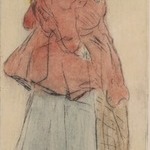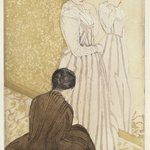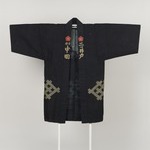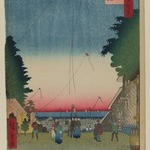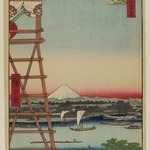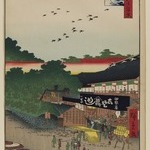Table of Contents, from One Hundred Famous Views of Edo
Utagawa Hiroshige, Baisotei Gengyo
Asian Art
Published by Uoya Eikichi in 1856–58, One Hundred Famous Views of Edo proved immensely popular, and to meet the demand a deluxe edition was assembled. This decorative table of contents was published in 1858, after the completion of the individual prints of the deluxe series.
Since Hiroshige died earlier that year, the series most likely had been forced to a premature close. Baisotei Gengyo (1817–1880), an artist best known for his decorative book jackets, was chosen to create this table of contents. While not an ukiyo-e artist proper, he had designed the table of contents for Hiroshige's Views of the Sixty-Odd Provinces in 1856.
The 118 prints in the series are here presented in groups according to the four seasons, a mode of classification deeply ingrained in Japanese art and literature, and followed in this exhibition. Abbreviated titles of the prints are arranged in the table of contents in five blocks, each with a distinctive decorative technique. The titles of spring scenes appear in two separate rectangles at the top; summer scenes are listed in a fan pattern in the middle; autumn and winter scenes are shown below. Production dates for the prints are given in a vertical date seal in the left or right border of each print.
The overall geometric pattern comprised of intricately designed parts is characteristic of late nineteenth-century Japanese decoration. The cartouche to the lower left offers the series title. Surmounting the title is Hiroshige's name and the advertisement that this series is his "grand farewell performance.' Below is the name and address of the publisher: Uoya (or "Fishmonger," apparently his former profession) Eikichi of Ueno Hirokōji.
MEDIUM
Woodblock print
DATES
10th month of 1858
PERIOD
Edo Period, Ansei Era
DIMENSIONS
Image: 13 3/8 x 8 3/4 in. (34 x 22.2 cm)
Page: 14 3/8 x 9 3/16 in. (36.5 x 23.3 cm)
(show scale)
MARKINGS
Publisher: Uoya Eikichi, Toeizan Hirokoji
SIGNATURE
Baisotei Gengyo (red cartouche, lower left)
ACCESSION NUMBER
30.1478.119
CREDIT LINE
Gift of Anna Ferris
PROVENANCE
Prior to 1930, provenance not yet documented; by 1930, acquired by Anna Ferris of Summit, NJ; 1930, gift of Anna Ferris to the Brooklyn Museum.
Provenance FAQ
CATALOGUE DESCRIPTION
"This decorative presentation of the contents of the "One Hundred Famous Views of Edo" was published after the completion of the entire series of 118 prints in the tenth month of 1858. (Hiroshige died in the ninth month of that year.) The final three designs (prints 12, 41, and 114) were approved the month after the artist's death, a fact that lends support to the theory that they are the work of his successor (Hiroshige II) and this table of contents was probably commissioned at about the same time. The artist chosen for this table of contents was Baisotei Gengyo (1817-1880), a designer best known for his decorative book jackets. Gengyo had already designed a similar table of contents in 1856 for Hiroshige's "Views of the Sixty-Odd Provinces." Gengyo's seal appears in the lower right corner. The 118 prints in the series are here presented in groups according to the four seasons. The cartouche to the lower left offers the series title, "One Hundred Views of Edo" (Edo Hyakkei, lacking the proper prefix meisho, meaning "famous places," which had probably already become understood in popular parlance). Surmounting the title is the artist's name (Ichiryusai Hiroshige) and the advertisement that this series is his "grand farewell performance." The titles of the 118 prints - usually shortened forms of those appearing on the prints themselves - are arranged in five blocks, each presented with a distinctive decorative technique. The spring scenes (prints 1-42) are arranged in two separate rectangles at the top, the summer scenes (prints 43-72) in a fan pattern in the middle, with a blind-printed wave pattern in the background, and the fall and winter scenes (prints 73-98 and 99-118 respectively) below; both in fabric printing. The order is normally in horizontal columns, right to left across the top and then across the bottom, except for the summer scenes, which are arranged in ten "slices" of the fan, right to left, each with three titles arranged in artistic calligraphic order. The grouping of the scenes within each season is geographical, but not in any predictable fashion. The background is difficult to read as a whole. A single blooming plum, a sign of spring, runs from top to bottom, against a ground of reddish brown, yellow, and green (replaced by a uniform gray or blue-gray in later impressions). A hototogisu against the full moon, a sign of summer, shares its space with the fan shaped summer group. Peeking out from the cartouches along the bottom are a haystack and sprigs of the seven grasses of autumn. Spring reappears in the narcissus at the bottom. Winter is absent. (Interpretation by H. Smith, 1986)
MUSEUM LOCATION
This item is not on view
CAPTION
Utagawa Hiroshige (Japanese, 1797–1858). Table of Contents, from One Hundred Famous Views of Edo, 10th month of 1858. Woodblock print, Image: 13 3/8 x 8 3/4 in. (34 x 22.2 cm). Brooklyn Museum, Gift of Anna Ferris, 30.1478.119 (Photo: Brooklyn Museum, 30.1478.119_PS20.jpg)
IMAGE
overall, 30.1478.119_PS20.jpg. Brooklyn Museum photograph, 2023
"CUR" at the beginning of an image file name means that the image was created by a curatorial staff member. These study images may be digital point-and-shoot photographs, when we don\'t yet have high-quality studio photography, or they may be scans of older negatives, slides, or photographic prints, providing historical documentation of the object.
RIGHTS STATEMENT
No known copyright restrictions
This work may be in the public domain in the United States. Works created by United States and non-United States nationals published prior to 1923 are in the public domain, subject to the terms of any applicable treaty or agreement.
You may download and use Brooklyn Museum images of this work. Please include caption information from this page and credit the Brooklyn Museum. If you need a high resolution file, please fill out our online
application form (charges apply).
The Museum does not warrant that the use of this work will not infringe on the rights of third parties, such as artists or artists' heirs holding the rights to the work. It is your responsibility to determine and satisfy copyright or other use restrictions before copying, transmitting, or making other use of protected items beyond that allowed by "fair use," as such term is understood under the United States Copyright Act.
The Brooklyn Museum makes no representations or warranties with respect to the application or terms of any international agreement governing copyright protection in the United States for works created by foreign nationals.
For further information about copyright, we recommend resources at the
United States Library of Congress,
Cornell University,
Copyright and Cultural Institutions: Guidelines for U.S. Libraries, Archives, and Museums, and
Copyright Watch.
For more information about the Museum's rights project, including how rights types are assigned, please see our
blog posts on copyright.
If you have any information regarding this work and rights to it, please contact
copyright@brooklynmuseum.org.
RECORD COMPLETENESS
Not every record you will find here is complete. More information is available for some works than for others, and some entries have been updated more recently. Records are frequently reviewed and revised, and
we welcome any additional information you might have.









